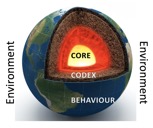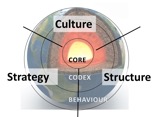A Systemic Map of Culture, Structure & Strategy

The great and confusing thing about maps of social reality is that there is a million of them and they are all accurate[i]. Unlike categorization models, which seek to explain and predict the world, social reality maps can be understood as frameworks of sense-making[ii]. Just like a common language, a shared sense-making framework is helpful to facilitate joint action.
The map I use to make sense of what happens within organizations is a simple one: It has three layers and three sectors. You can imagine it like our Planet Earth.

The innermost layer is the “Core”. In our planetary analogy we might think of it as a ball of boiling hot matter containing the passions, deeper values, beliefs and basic assumptions about the world that form the organization’s magnetic field. Often the Core is coined at the founding moment of the organization, but it may shift and develop with new important people joining and meaningful events imprinting on the Core. It hardly ever is a homogenous matter and while this can be strenuous, it is not necessarily a problem. The most exciting organizations I know are powered by conflicting forces within their Core that create tension and drive development like the poles of a battery. The most tragic ones have forgotten about their Core and can’t “feel” themselves.
Wrapped around the Core there are several coats of rock – formal arrangements that make up the “Codex” of the organization. Here we find statutes, configurations, strategic plans, rules and operating procedures – the hardware and operating systems that provides the more or less stable shape and profile of the organization.
The third and outermost layer is dynamic. It hosts the organizational equivalents of water, organic matter and lifeforms which we may call “Organizational Behavior”. This surface layer interacts directly with the environment and is as much influenced by external factors as it is by the inner forces and deeper layers of the organization. It comprises both, people following formal routines and people “doing their thing” to form what has been coined the “Shadow System”(Ralph Stacey).
The three layers are compatible with Ed Schein’s model of organizational culture: Artefacts (effects and traces of culture we find on the surface in the daily life of organizations) mostly belong to the layer of Behavior. Espoused Values (formal value statements and written commitments of cultural conduct) are part of the Codex. Underlying Assumptions (the deeper, partly unconscious beliefs and value systems) in turn lay within the organizational Core.

The sector dimension of the map focuses on the triangular relationship of Organizational Culture, Structure and Strategy. The three subsystems divide only the Codex and the Behavior layers with the Core building the common base of all three sectors. As there are many ways of conceptualizing Culture, Structure and Strategy it may be helpful to provide a set of working definitions here.
The subsystem of Culture in our model relates to the way relationships are made up in the organization – the “soft side of how things are done”. Organisational culture is rooted in social beliefs and philosophies (Core), formalized in value statements and guidelines on issues like leadership and collaboration (Codex) and lived out in the very concrete practices of everyday social interactions (Behavior).
The Structural subsystem determines how the workflow and decision process are organized – the “hard side of How”. Its foundations are again deep seated beliefs and norms related to work and social development (Core), its formal manifestations include organizational charts and operational routines (Codex) while the outer layer is represented by informal structures and real life processes (Behavior), including the many shortcuts and micro-political tactics taken on a daily basis.
Finally, the subsystem of Strategy defines the organization’s goal orientation and mode of generating impact – the Why and the What. Strategic elements of the Core are passions and deep level theories of change, formal elements of the Codex are strategic plans and business models while the layer of Behavior is represented by the actual portfolio of (useful and senseless) activities and projects the organization is engaging in.
Organization development can step in at all three layers and all sectors. In many cases the initial focus of a development process will deepen and shift and other sectors will come into view. Sometimes, working on the outer layer of one sub-system will reveal more deep seated issues in the Core which in turn effect other sub-systems. You cannot merely drive a new strategy or install a new functional structure without considering how this fits with your organizational culture (the famous quote “Culture eats strategy for breakfast” is expressing nothing less[1]). The same issue is highlighted in Tychi’s metaphor of the “Strategic Rope”, which describes the intertwining of subsystems, which stabilizes the organisation, while at the same time inhibiting change within the overall system. We need to look at our organizations holistically but sometimes we need to untangle and dissect their subsystems in order to initiate development. Let’s take a look at different approaches to working with the three layers.
Working on the Core
It is pointless to work on an outer layer of the organization if a problem is rooted in mental models and belief systems within its Core. Unfortunately, it is very hard to get to the Core. Sometimes it erupts, spills out to the surface, burns down a village and then hardens as a strange black mass, but usually it works invisibly through the other layers from within[iii]. To get to the Core we need a heat suit and a deep diving protocol such as Glasl’s U Procedure (later taken on by Otto Scharmer to inspire Theory U) or deep dialogue techniques that tap into the narrative and the collective subconscious. Following the Discrepancy Analysis, we can also deduct the inner make-up of the Core by tracing the misfits between the Behavior and the Codex: If a value statement says to trust people with responsibility, however, the dominant decision practice is top down, something might be off in the Core (e.g. fundamental beliefs on peoples’ capabilities such as McGregors Theory X)[iv]. In fact, it is not too rare that the Codex will contradict the Core as it is often used as a means to drive deeper change: If we write on the office wall that we all love and respect each other, maybe it’s true; more likely it is something we wish for.
Working on the Codex
Working on the Codex is the classic business of designed change. It involves developing statutes and plans, shaping structures and processes and formulating guiding principles. In the traditional organization development approach, this process involves a diagnostic sequence (what is the status quo and how is it working out?), a targeting sequence (how would we like things to be?), a planning sequence (what could this look like in detail?) and – after a formal decision – an implementation sequence (how do we get it into practice?). In many OD processes the implementation, which reaches into the behavior layer of the organization, is wildly underestimated. Change agents often believe that once a new structure or plan is ratified, behavior will change with it – especially if the development process was somewhat participatory. In reality, this is when the actual work starts.
While the diagnose-target-define-implement choreography still is dominant practice, agile development approaches are quickly gaining traction. They incorporate quick loops of assessment, planning and implementation within a trial and error mode, thus keeping the Codex lean and flexible. The far end of this development is a Codex which is reduced to a set of principles that sit close to the Core and help the system continuously self-organize without further mediating structures and plans. It must be noted here that such “minimal-structuring” does not equal the absence of structure. Principles are high level frames in which organization behavior is oriented. Organizations that fail to provide such high level frames are in danger of being absorbed with the internal consequences of creeping disintegration.

Working on Organization Behavior
The first unsexy aspect that comes to mind when thinking about working with organisation behavior is regulating and policing: We have rules so let’s make them stick. If people are not conforming to them, let’s motivate them with incentives or sanctions. A somewhat nicer but no less ambivalent analogy may be gardening: If we want the “right” plants to have space and light, we need to weed the “wrong” ones out; if we want a fruit tree to be sustainably productive and healthy, we need to prune it and remove branches that suck energy and prevent light and wind from going through. Strategically sorting out what an organization does, is not much different: A portfolio analysis can effectively help to sort out activities that are non-productive, both, in the sense of mission and overhead contribution. However, how can we best assess this contribution? How can we tell the “right” plants from the “wrong” ones? If the only guideline for weeding is, whether or not something conforms with the plans and regulations, we kill innovation, we kill emergence and we kill learning. Therefore, it may be very wise to turn the relationship: Yes, agreements should be kept and patrolled (otherwise a group is a crowd and an organization is just some lines in the sand). The true art is, to craft agreements that are rooted in patterns of behavior and that are reviewed as often as these patterns change with the needs and circumstances they reflect. In simpler words: instead of making people conform to structures, how about making structures conform to people? The next chapters will spell out some ideas and approaches of how this can be done.
[1] Wether it actually originates from Peter Drucker seems to be under debate (how can that be?)
[i] The constructivist would be more generous here: currently there is actually 7 billion of them… and counting. Unlike models, which are all wrong (while some remain to be helpful)
[ii] In the words of David Snowden, the ingenious father of the Cynefin framework: in a categorisation model the framework precedes the data (which is good for exploitation), while in a sense-making model the data precedes the framework (which is useful for exploration).
[iii] I apologize for the improper geology at this point – clearly it is the magma of the mantle that erupts
[iv] Such a conclusion has to be taken carefully though, as any behavioral pattern can also be an effect of external factors such as dominant sector practice or expectations by partners and clients.

